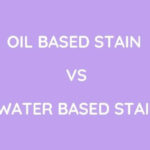A good coat on top of your furniture can make the furniture durable. There are many different coats available in the market. One of the best is polyurethane. They come in two types- water-based and oil-based polyurethane. Many of us don’t follow the right way to spray polyurethane. So here we are to give the steps needed in detail to spray polyurethane.
Contents
How To Spray Polyurethane – Step By Step Guide
Polyurethane can give our wood an excellent and durable finish. The water-based polyurethane is easy to spray, but the oil-based one will need some effort. Brushing the polyurethane can give us many troubles.
They need a lot of focus and can be uneven too. This is why spraying is the better option, and it is not a very hard job. A little practice can make the job easy and fast to finish.
Total Time: 45 Minutes
Step 1: The Material
Before taking the spray in hand, make sure the material is in the right stage for the coating. So before coating the material, have it ready. Remove the irregularities on the surface of the material. A sander will be useful to make the surface smooth. Sanding the surface can also remove any other materials on the surface. So after getting the surface smooth and neat, apply a layer of stain.
Allow the stain to dry for some time. The next thing is to clear any form of dust from the material. The polyurethane coating will work better if the material is dust-free. A spray tent is a good tool to keep the dust away from the material. Setup the workspace also clean so that there are no chances of dust formation. A clean place can also allow the user to focus on the work in peace.
Step 2: A Good Sprayer
So the next important part of the project is the sprayer. It is going to help us apply the coat on the material. So a good sprayer is also key in finishing the task. Before choosing the sprayer, study about the sprayer tip. For spraying polyurethane, a tip that sprays a width between 1″ to 6″ will be ideal. Even for many other finishes, this will be a perfect width.
The next important part is the volume control knob. So before spraying polyurethane, remember we need an even coating with each pass over. Even a little more or less coating can give us troubles. So make sure to adjust the volume control knob. So before starting the main project, practice in some scrap piece to get it right. If the material is extensive, it may need work for a long time. This can make our hands tired, and we may make mistakes that can make our coatings uneven.
So get a spray handle if your sprayer doesn’t have one. The handle should allow us to work with all our fingers rather than a few. This gives us a firm grip over the tool and can work without much pain.
Step 3: Priming
Before applying polyurethane, it is best to prime the material. So for those who are new to painting or spraying, priming is not a regular job. Priming is like an undercoat we apply before painting or spraying. It gives a better adhesion of paint and even is like extra protection to the surface. Priming provides the user with a stable surface and can hide surface stains.
The priming mixture is different for every paint and coatings. The priming mixture for polyurethane needs polyurethane itself and paint thinner. A mixture of the ratio 2:1 of polyurethane and paint thinner. Put this in the sprayer and start the coat. After the first layer, check the surface of the material. If it is good, check, and the next step is spraying the polyurethane.
Step 4: Spraying Polyurethane
Spraying may look like an easy job from a distance. But there are a lot of factors to consider while spraying any coat. The primary job is to get the spray angle right. We have to spray in an arc as it gives us more coverage at the center of the surface. To get excellent and uniform coverage, overlap the spray pattern. This is for avoiding massive deposits at the edges of the overlap. But the overlap should be about 50 % over the previous spray.
The distance between your tip and the surface must be even throughout the process. A change can result in an uneven coating on the material. Keep the sprayer about 10″ or 12 ” away from the surface. This can even prevent the formation of globs on the surface of the material—the same for the speed too. Maintain the speed uniform while spraying for better results.
Many thin coats are a better option than a single thick coat. This even prevents runs and help us have a good finish. Keep spraying until we get a good coating on the material. A horizontal setting will be apt for spraying across an area and comprehensive materials. The vertical setting is better when we spray up and down like spraying the table legs. A middle setting spray will be the right choice for the corners and edges.
Step 5: Finishing
We may observe stains on the material at times. Do not try to cover it again with the polyurethane as it is not the best solution. A mist coat will be an excellent solution to this problem. Sometimes how proper we work, there are chances of runs or blemishes. A razor blade is an excellent choice to remove this but make sure the material is not cut deep by the blade.
The bumps can also be an issue at the end—Wet-sand the surface to ensure that even minute bumps are not there in the material. Get your sandpapers wet to do the wet-sand the bumps and blemishes out. Leave the material untouched for at least two days and then give the final coat. Leave it untouched again for two days and then focus on polishing the surface. The polish is to sand out any existing blemish in the material.
About three coats could give the perfection we expect. A light sanding between each coating will make it even better. A 220 grit sandpaper is enough, as we need not remove the layer. Again dust also can be an issue between each coating. A vacuum may help us clean the surface so that we don’t have to worry while spraying the next coat. Dust can ruin our job and make the finish look cloudy. So don’t forget sanding and removing dust between each coating.
Things Needed To Spray Polyurethane
Here is the list of the things necessary to spray polyurethane
- A good sprayer with the right tip
- A paint thinner for priming
- Polyurethane (oil-based)
- Sander with the right sandpaper. The sanding between coatings may need different sandpaper.
- Razorblade
- Vacuum to clean off the dust
- A spray tent
- Wet-sand for removing bumps
Spraying polyurethane needs some experience and practice at the beginning. Once learned, they are an effortless job to finish. The given steps are the best ones for spraying oil-based polyurethane. Water-based polyurethane is easier to spray, and standard methods are enough for it.
FAQs
1. What are the differences between water-based polyurethane and oil-based urethane?
2. Which type of roller is apt for polyurethane?
3. How many coats of polyurethane should we give for a finish?
4. Can we use steel wool instead of sandpaper for sanding the surface?
Conclusion
Sealers like polyurethane are very durable and essential for projects. They are an excellent choice of coating for wood. Polyurethane can give a high-quality and robust finish. Spraying polyurethane may look complex. But some practice is enough to do it right. Following all the steps about how to spray polyurethane will give us a perfect coating. We hope your confusion on spraying polyurethane is now gone.








Leave a Reply